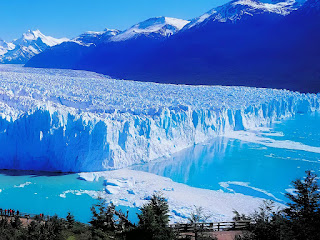The first man to ever set foot in this glacier was Juan Tomas Rogers, the English captain of the Chilean Army, in 1879. It was not until the beginning of the 20th century that the Glacier became known through the scientific work and pictures taken by Hauthal. Later on, the unstoppable Federico Reichert, the father of Argentine Andean mountaineering, walked through the glacier up to its source in the Southern Patagonia Ice Cap in 1912.The glacier became more and more popular year after year and today it is the best-known glacier in the world.
We will begin by defining a glacier as an immense mass of ice which has two very different zones: the accumulation zone and the percolation zone. In the accumulation zone, it is constantly snowing. In the percolation zone, the glacier looses ice mass due to evaporation and melting (mainly in summertime). These huge masses of ice move down due to the slope of the valleys in which they are situated and end abruptly in lakes or cliffs, or softly forming terminal moraines (accumulations of stones and dirt pushed by the glacier).
It is worth mentioning that there are glaciers in many areas of the world: the Andes, the Alps, the Himalayas (Nepal), Antarctica, New Zealand, Karakorum (Pakistan), the North Pole, and even in Africa!!!, in Mount Kilimanjaro and Mount Kenya. But none of them has the unique features of the Moreno Glacier.
There are 3 main features that make this glacier different from the others: its access, its condition and the breaking phenomenon.
1) Access: Few glaciers in the world can be accessed in such a simple and safe way as this one. The Moreno Glacier is located at 185m above sea level and 80km away from El Calafate (the nearest town). You can walk over the glacier after a short 15-minute walk around Lake Rico. Most glaciers are in very high places or in places with extreme temperatures, so this is one of the reasons why Moreno Glacier is so popular.
1) Access: Few glaciers in the world can be accessed in such a simple and safe way as this one. The Moreno Glacier is located at 185m above sea level and 80km away from El Calafate (the nearest town). You can walk over the glacier after a short 15-minute walk around Lake Rico. Most glaciers are in very high places or in places with extreme temperatures, so this is one of the reasons why Moreno Glacier is so popular.
2) Condition: Since 1917, the Perito Moreno Glacier is stable, meaning that its surface, width and length have remained the same since then. This shows that the snow increase in the accumulation zone is enough to compensate what is lost in the percolation zone, mainly on account of melting.
3) Breaking: This spectacular and unique phenomenon has taken place since 1940, when the first known breaking took place.
The breaking process begins when the glacier reaches the Magallanes Peninsula, obstructing the drainage of the Lake Rico into the Lago Argentino. This causes the level of the Lake Rico to rise every day because of the ice melting in the highlands and the lack of drainage. Some months or years later, the pressure produced by all that water (7m in the last breaking of March 2006) causes the glacier to break. The breaking itself can take between one day and a whole week, depending on the amount of water accumulated in Lake Rico and the ice mass preventing the water from passing through.
The breaking cycles are very irregular and vary from 2 to 16 years. We were very lucky with the breakings of 2004 and 2006, but the previous breaking had taken place in 1988!
The breaking process begins when the glacier reaches the Magallanes Peninsula, obstructing the drainage of the Lake Rico into the Lago Argentino. This causes the level of the Lake Rico to rise every day because of the ice melting in the highlands and the lack of drainage. Some months or years later, the pressure produced by all that water (7m in the last breaking of March 2006) causes the glacier to break. The breaking itself can take between one day and a whole week, depending on the amount of water accumulated in Lake Rico and the ice mass preventing the water from passing through.
The breaking cycles are very irregular and vary from 2 to 16 years. We were very lucky with the breakings of 2004 and 2006, but the previous breaking had taken place in 1988!
Source : www.hieloyaventura.com





















0 comments:
Post a Comment